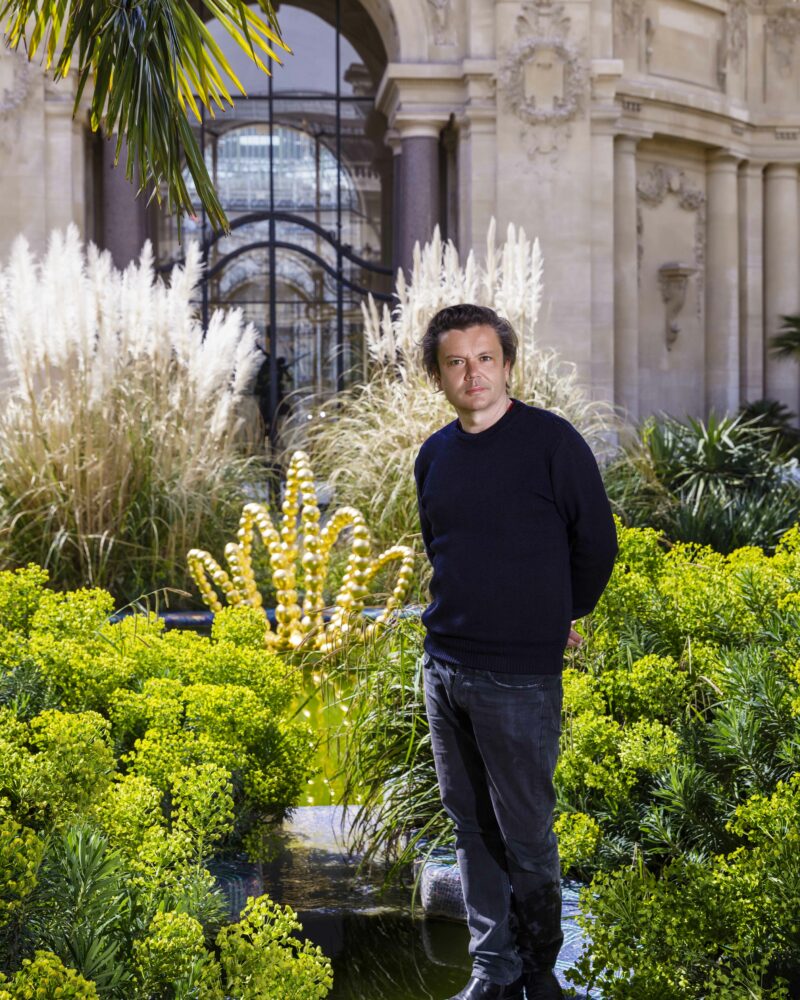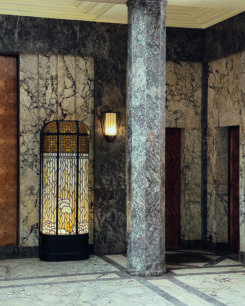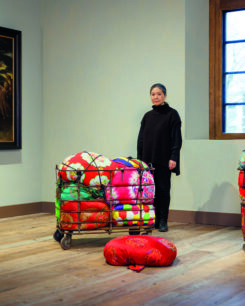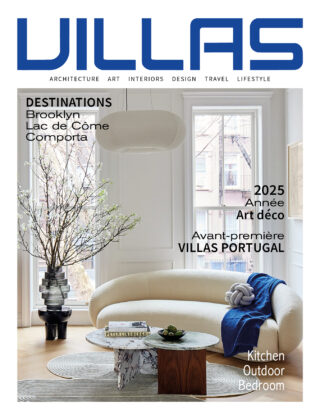Sommaire
The beginnings of a promising artistic career
Jean-Michel Othoniel was born on January 27, 1964 in France. As a child, he regularly visited the Museum of Modern Contemporary Art in Saint-Étienne, his hometown. A place that he particularly appreciates and that makes him want to be part of the art world. This is how he decided to study in this field. In 1988, the artist graduated from the École nationale supérieure d’arts de Cergy-Pontoise. In 1992, he presented his first creations in wax and sulphur at the documenta in Cassel. From then on, his career was launched and his fame grew day by day.
The following year, in 1993, the artist discovered blown glass in Marseille, at the CIRVA (International research centre for glass and arts), and integrated it into his works. A noble material which then became his signature, the cornerstone of his artistic work. From then on, he collaborates with glassmakers from Murano to Venice and experiments with glass in different states: transformations and mutations. He creates unique creations such as hollow beads as well as glass necklaces, hung in the gardens of the Villa Medici or in the Alhambra Palace in Granada, which now mark out all his work.
In 2000, Jean-Michel Othoniel was commissioned by the Paris public. In the heart of the French capital, on Place Colette, opposite the Palais-Royal Theatre, he transformed the Palais-Royal-Musée du Louvre metro station into a unique work: Le Kiosque des noctambules. A double crown of coloured glass and aluminium overhangs the metro station. This monumental and fantastic object, striking in the Parisian urban setting, welcomes the flow of passengers as an invitation to daydream.
Since then, his in situ works regularly encounter gardens and historical sites around the world. Considered as one of the major contemporary artists, he was elected member of the Academy of Fine Arts in November 2018. In 2019, the latter opened in Montreuil, a gigantic studio with the Belgian sculptor Johan Creten, his companion. In this place, named La Solfatara, he shares their skills and works that are dear to them; a dialogue between glass sculpture and clay sculpture.
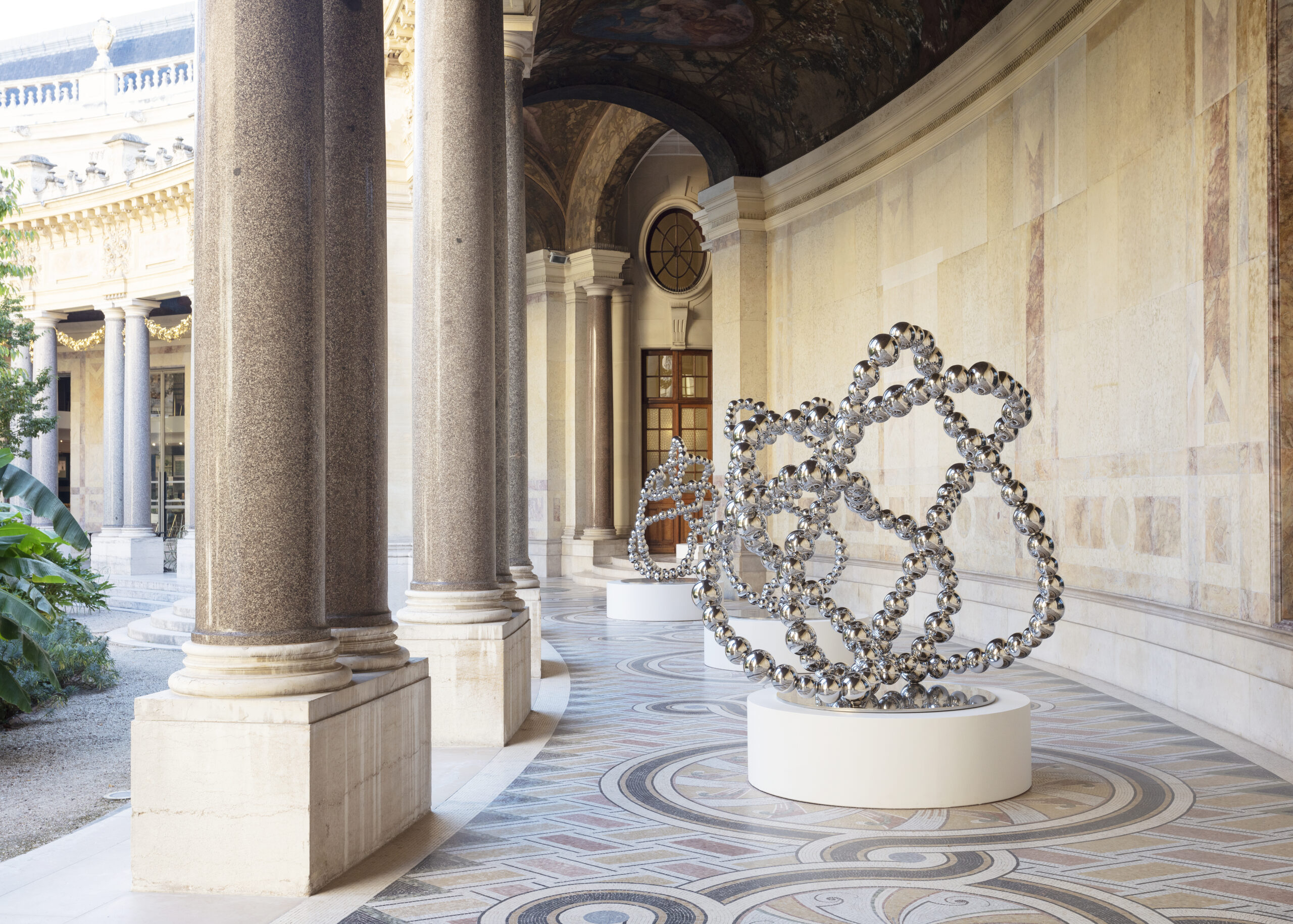
Jean-Michel Othoniel/Courtesy of the artist, Perrotin | « Le Théorème de Narcisse », Petit Palais, 2022
Emblematic glass exhibitions and monuments by Jean-Michel Othoniel, one of the greatest French artists
The Othoniel Studio team is pursuing a vast project: to poetize and reenchant the world. The sculptures of the contemporary artist, halfway between jewels and fairy-like objects, reinvent the marvellous.
Some of Jean-Michel Othoniel’s emblematic works and exhibitions:
- In 2003, the “Crystal Palace” exhibition held at the Fondation Cartier pour l’art contemporain in Paris unveiled a series of glass sculptures in the rooms and gardens, inviting visitors to wander through the space.
- In 2010, the star Jean-Michel Othoniel participated in the restoration of the Villa Empain in Brussels. He creates a monumental work in Murano glass and gold leaf to decorate the entrance hall.
- In 2011, the Centre Pompidou offered him a carte blanche exhibition: “My Way”. A retrospective of his career as an artist.
- In 2015, he brought the bosquet of the Théâtre d’Eau at the Château de Versailles to life with his creation Les Belles Danses. The gardens host three fountain sculptures placed flush with the water in the basins.
- In 2018, the French visual artist presents a solo exhibition in a place to which he is deeply attached, the Museum of Modern and Contemporary Art in Saint-Étienne. The Big Wave, a large sculpture of black glass bricks, is inspired by the tsunami that struck Japan in 2011.
- In 2019 in Doha, the artist animates the basin facing the National Museum of Qatar with an installation of 114 fountain sculptures. Works in the form of arabesques. A spectacular building, called Alfa, which extends over 900 square meters.

Jean-Michel Othoniel | Musem Qatar
Until a new solo exhibition at the Perrotin Gallery in Hong Kong in early 2022, Jean-Michel Othoniel presents his largest solo exhibition since “My Way”, which he sees as a parenthesis outside of time.
For the occasion, he invented Le Théorème de Narcisse: a man-floral work which, by reflecting itself, reflects the world around it. This event takes place in Paris, at the Petit Palais, near the Champs-Élysées and the Arc de Triomphe, recently wrapped by Christo, the famous master of wrapping.
This exhibition is placed under the sign of unreality, enchantment and imagination. The French artist presents Rivières de briques bleues, Lotus and Colliers d’or, Couronne de la Nuit, or Nœuds Sauvages. 70 pieces in dialogue with the architecture of the Petit Palais.
The marriage of art and science: Jean-Michel Othoniel’s artistic signature
At the age of 23, Jean-Michel Othoniel went through a terrible ordeal. He lost his first love and it took him years to find a certain joy. At that moment, art is for him a kind of outlet, a form of psychoanalysis. He decided to transcribe this suffering in his works. He became an artist of sulphur, working with it in different forms. This material has the particularity of being reflective and reversible. It allows the creation to evolve and metamorphose, a characteristic that captivates the contemporary artist. In 1992, he flew to the Aeolian Islands in Italy, hoping to discover more about sulphur.
During this trip, he meets a volcanologist who presents him with the merits of natural glass from volcanoes. According to the latter, the pumice stone that covers the island, once melted, turns into obsidian. This was all it took to appeal to Jean-Michel Othoniel. He then pursued his passion for the marriage of art and science by conducting two years of research at the CIRVA. “It was an alchemical act, it was the metamorphosis that interested me, not the glass itself”. Little by little, he was seduced by the beauty of this material and found joy and happiness. From sulphur to glass, he passes from the shadow to the light and decides to reenchant life.
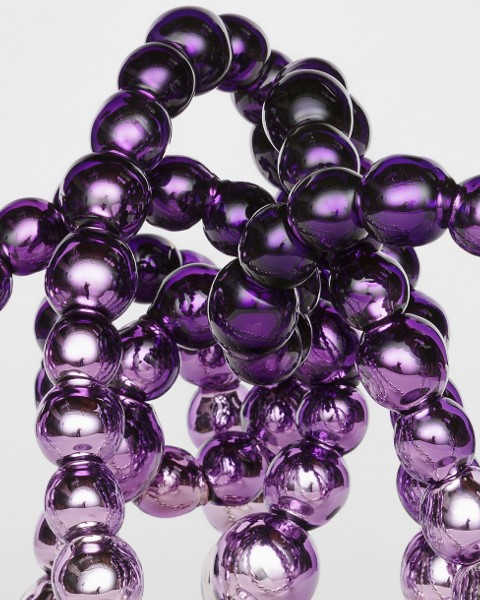
Jean-Michel Othoniel | Kiku Perrotin

Jean-Michel Othoniel | Agora Perrotin
He discovers the marvelous metamorphosis capacities of glass and wishes not to intervene as a sculptor to shape or destroy the material, but rather to seize it in a moment of fragility, in the state of sand or during its liquefaction. The artist realizes that he cannot manipulate glass alone, as was the case with sulphur or wax. He had to be a virtuoso. He therefore called on glassblowers from all over the world: Japan, India, Mexico and even Hawaii.
In the course of his creations, the sculptor explores the ideas of transformation and material mutation, he also discovers the theory of reflections with the Mexican mathematician Aubin Arroyo. A mathematical theory of the knot revealing the existence of millions of others, a cross between art and mathematics, between the rational and the intuitive. Jean-Michel Othoniel is developing this theory in the sculptures on display at the Petit Palais.
He then creates works like real scientific experiments. He also strives to design creations that harmonize with the landscape. The French artist intertwines his glass beads and necklaces with the vegetation and the environment. Behind each sculpture, he also deals with a deep subject. Some evoke his love for travel, others testify to his reflections on the world or tell a fantastic and poetic tale. He likes to tell stories through art.
For almost 30 years, Jean-Michel Othoniel has been surprising us with timeless works that are increasingly fascinating and spectacular. Fantastic creations that invite us to dream and offer us the possibility to resist the disillusionment of the world for a while and to taste the marvelous during an exhibition.
